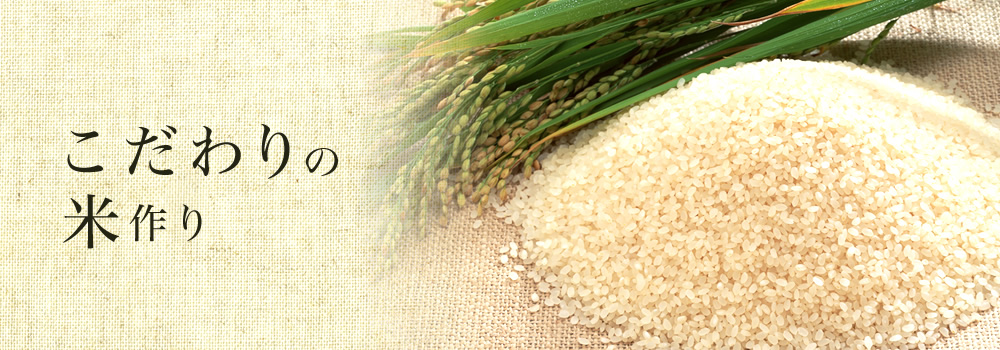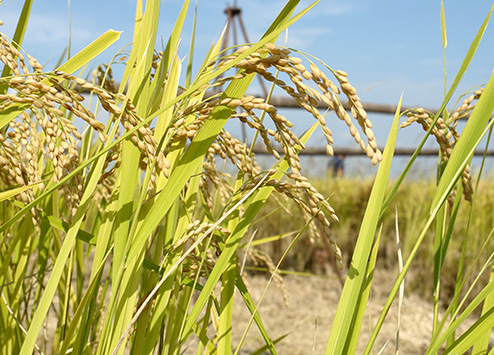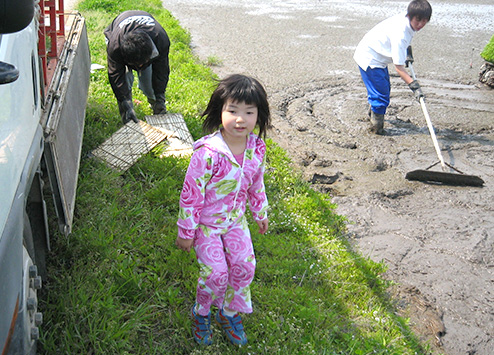With our organic cultivation method established by our co-operation, compost becomes rich of nutrients as time passes and creates a plump grain. Unlike the conventional rice that is pure white, our rice grain has a bright yellow hue that masks the white grain when harvested.
Daily Excitement in the Fields
From planting the seeds to making a full rice field, we are given the opportunity from nature to create and live from the harvest it provides. This is what farming is to us.
Early morning of summer, we would see a red dragon fly mature and at night we see fireflies illuminate the rice fields. This used to be common scenery in the past that we do not see as often anymore due to destruction of ecosystems. Our duty as farmers is to preserve the ecosystem that we are fortunate to grow crops on. This is what is most important to us. Our job is to put in our mind and efforts into growing crops without disturbing nature's ecosystem as much as possible. We study daily on how we can participate in farming while being in a harmonious relationship with the ecosystem.
The most difficult part of this job is removing the weeds. After three weeks from seeding the field, we use a machine to get rid of the weeds. The machine will make two rotations before we would have to pluck out the weeds by hand. Although this process is labor intense, seeing the dragon flies and fire flies coexisting with the field that we have made makes us happy. Early morning of June, we would see larvae of a dragon fly dry its wings on the rice plant and fly off. Being part of this cycle of nature makes us want to preserve this for generations to come. This is why we cannot use chemical pesticides and weed killers.
We standardize our cultivation process in our Kamo Organic Rice Co-operation manual and have our members follow guidelines listed in this manual. Participants in our organization are constantly introducing new methods and ideas to keep our rice at a higher standard. We are currently expanding these methods to developing countries.
Kamo Organic Rice Co-operation's Specially Cultivated Koshihikari Rice's Characteristics.
-
Rice Color
-
Perfected Firmness
Organic fertilizer ferments and excretes nutrients gradually in the rice field as time passes. Koshihikari rice takes time to grow so more nutrients get absorbed into the grain as it matures. This rice has a very distinct firmness and stickiness when consumed.
-
Distinct Softness
Due to its characteristic of having a sticky consistency in comparison to conventional rice, cooking Koshihikari rice a little firmer will give it the perfect balance between flavor and texture.
-
Sweet Taste
Koshihikari rice is modestly sweet and the flavor is consistent even when it cools. Perfect for lunch.
-
Rich Fragrance
Freshly cooked Koshihikari rice has a distinct sweet aroma. New crop rice has the strongest fragrance when cooked.
-
Consistent Flavor
The rice retains its flavor even after time passes since cooking. Because the surface of the rice is firm, discoloration after time also is minimal in comparison to conventional rice. We do not use chemical pesticides for our rice and that is how we can serve healthy, tasty, organic rice.
Our Rice farming Policy
-
Protecting the present ecosystem
To preserve the green environment we currently reside in, we focus on being organic from start to finish. The soil we grow our rice plants are free of chemical and synthetic pesticides. Being committed to organic is no easy task. Daily tasks such as scattering soil and plucking out the weeds must be done by hand. Although this is strenuous labor, we believe that this method of producing rice will preserve our environment for future generations to use the land.
-
Creating the field that creates the Rice
Our foods must be safe to consume. For this to be true, we must take into consideration how our food is made. Within our co-operation of rice growers, it starts with creating the field. To create a field, we must create the soil. A good plot of soil needs to be able to host a lot microbes and bacteria.
We create our own soil by plowing the compost and spreading organic soil across the field. This procedure is essential for a rice plant to grow strong and be resistant against diseases and insects. Although using chemical pesticides can eliminate this long procedure, this is not how we farm our rice. -
Growing Healthy Rice
We give the rice plant seedlings lots of space from one another so that each seedling has enough nutrients for itself and space so the stem can grow thick. By giving each plant enough space for wind to travel, it is harder for the plant to get damaged from insects. Also, with a thicker stem, more nutrients travel to the grain, making each grain plump and tasty.
Special Production Sequence of "Koshihikari Rice"
| MAR Seed disinfection |
●Seed disinfection Place seeds in 60 Degrees Celsius hot water for 3 minutes to kill "Bakanae" disease. ● Preparation of bed soil mix organic compost matter and rice hull into pasteurized soil.Organic fertilizer is made from fat free rice hull that absorbed fish extract (liquid excreted from creating dried fish powder products.) |
JUL Fertilizing |
●Fertilizing Replenish organic fertilizer to fields that ran out of fertilizer. ●Remove weeds ●Water maintenance Replenish water supply in preparation for heat. |
|---|---|---|---|
| APR Seeding |
●Creating the bed soil of the rice field Use machine (Broadcaster) to spread organic fertilizer evenly through the field. ●Coating Ridge of Field To maintain water depth of rice field, we coat the ridges of the field yearly. ●Seeding Plant a box full of seeds (160g) evenly ●Sprouting leave sprouts in a green house in a non heating environment. |
AUG Water maintenance |
●Water maintenance Adjust water supply according to heat. Replenish enough water to avoid heat damage ●Remove Weeds |
| MAY Planting |
●Seeding the Rice field Plant 16 to 18 boxes of the sprouted rice plants. Plant them in the field shallow. ●Spacing out the planting this is in case a plant is diseased or dies. Spacing will help to slow down the effect on surrounding plants. ●Water maintenance maintain deep water and prevent weeds from sprouting. ●Weeding Once to twice a week, pull chains on the rice field to kill weeds. |
SEP Harvesting |
●Harvesting It is critical to harvest the rice at the right time. ●Drying process take 1.5 times more time than conventional drying process. ●Husking Remove rice hulls and separate underdeveloped rice (less than 1.85 mm) in the grader. |
| JUN Creating a Ditch |
●Remove weeds Remove weeds with manual machine. Do it twice. ●Making a Ditch Create a ditch in preparation for summer drought. |
OCT to FEB |
●Coating the rice field ridges This enables to adjust water levels. ●Landscaping to flatten out the rice field, move higher elevation soil to lower level. ●Transportation After husking, move rice in a cooler. ●Preservation stock the rice in a 15 degrees Celsius warehouse. ●Creating the soil Spread compost on the bed soil to create rich nutrient soil. Spread fertilizer and rice bran, plow land, and prepare land for plantation again. |
| AUG Water maintenance |
●Water maintenance Adjust water supply according to heat. Replenish enough water to avoid heat damage ●Remove Weeds |
|---|---|
| SEP Harvesting |
●Harvesting It is critical to harvest the rice at the right time. ●Drying process take 1.5 times more time than conventional drying process. ●Husking Remove rice hulls and separate underdeveloped rice (less than 1.85 mm) in the grader. |
| OCT to FEB |
●Coating the rice field ridges This enables to adjust water levels. ●Landscaping to flatten out the rice field, move higher elevation soil to lower level. ●Transportation After husking, move rice in a cooler. ●Preservation stock the rice in a 15 degrees Celsius warehouse. ●Creating the soil Spread compost on the bed soil to create rich nutrient soil. Spread fertilizer and rice bran, plow land, and prepare land for plantation again. |
The taste of rice can drastically change with cultivation, preservation, and polishing methods. To keep the consistent quality taste, we keep the temperature at 15 degrees Celsius at 60% humidity in our warehouse all year around. For polishing, we utilize specialized machines such as stone pickers, color sorting machines, and metal magnets to separate the best rice grains from debris and spoiled grains.
Preservation of Rice (After opening bag)
【Precautionary measures when preserving rice in the refrigerator】
Always put rice in a sealed container When rice is too dry, it has the tendency to crack. Sealed containers help rice from getting too dry. After use, seal and put back in fridge immediately.
【Prolonged exposure to temperature change( Fridge to Room temperature)】
can lead to break down of rice and mold.
How to cook White rice
- ①Put rice and water into a bowl. We recommend mineral water. Make sure to measure rice in desired amount in cups.
- ②Stir gently and pour out water immediately.
- ③Pour water and wash until water becomes clear. Wash the rice with fingers, do not wash too hard with palm, rice grains will break if done rough.
- ④The last rinse is to throw out the remaining murky water. Never put rice on draining basket, rice flavor will be gone
- ➄Put rice and water into a rice cooker. We recommend mineral water. Soak 30 min in hot season, 40-60 min in cold season, soaking in the refrigerator recommended. Align water quantity (measured in cups) to line on rice cooker pot.
- ⑥Put the switch on, wait 10 min after cooking is completed to ripen the rice.
- ⑦Stir with rice scooper as if you are slicing rice grains, do not crush rice. This is to cut out the steam from the freshly cooked rice.
How to cook genmai (brown rice/unpolished rice)
- ①Put rice and water into a bowl. Make sure to measure desired rice amount in cups. We recommend mineral water.
- ②Stir gently and pour water out immediately. There is no need to wash brown rice like white rice.
- ③Drain the water by putting brown rice in a strainer.
- ④Soak
-If your rice cooker has “Genmai Mode”, soaking is unnecessary. Start cooking immediately.
-If your rice cooked does not have “Genmai Mode”, soak brown rice for 1 night (7~8hrs) in a refrigerator
*-If you don’t have time, soak brown rice for at least 30 min in 1.5~2 times the quantity of water in terms of cups. - ➄Rinse completely again, put brown rice and water into a rice cooker. We recommend using mineral water. Please reference rice cooker pot for water quantity before cooking.
- ⑥Turn the switch on. Wait 10 min after cooking the rice to ripen the rice.
- ⑦Stir with rice scooper as if you are slicing rice grains, do not crush rice. This is to cut out the steam from the freshly cooked rice.
Mold and Insects on Rice.
There are times when insects and mold shows up in your batch of rice. It is more common in summer but it can happen in times of winter.
Nemapogon granella: it is 3 to 5 millimeters as a larva but will get larger and eat the grains of rice for nutrients. Will form a cocoon and turn into a moth.
Eating rice once opened Insects appear in the rice batch as environment temperature rises to over 27 Degrees and when humidity is high.
Best way to fight against pest is to preserve in a cooler place and keep it in a closed container to avoid humidity.
Mold that form on organic rice is not cancerous or poisonous. Even if accidentally consumed, it will not cause harm to health. We do not recommend eating molded rice because it is tasteless.
●Transported in cargo with fermented products such as miso or soy sauce
●Drastic change from cool to warm temperature
Please carefully take care of rice.







